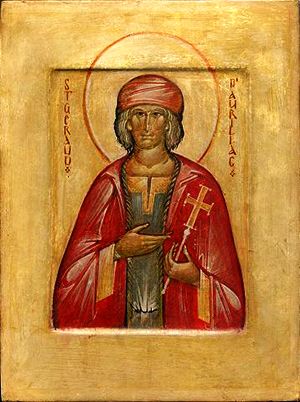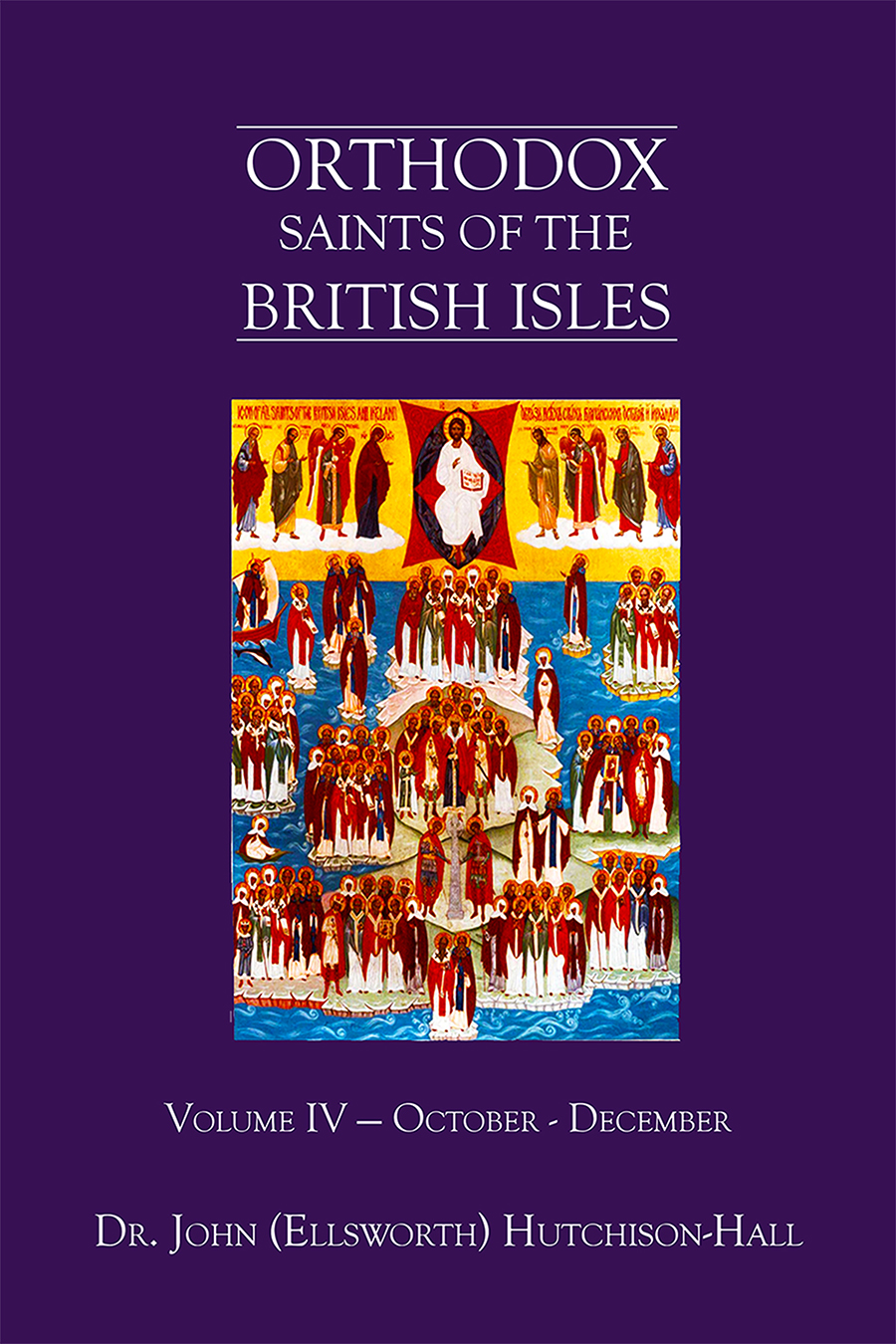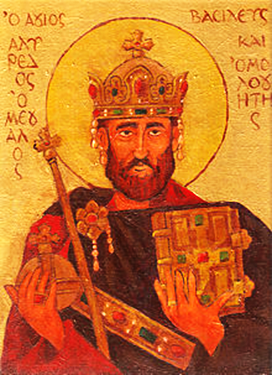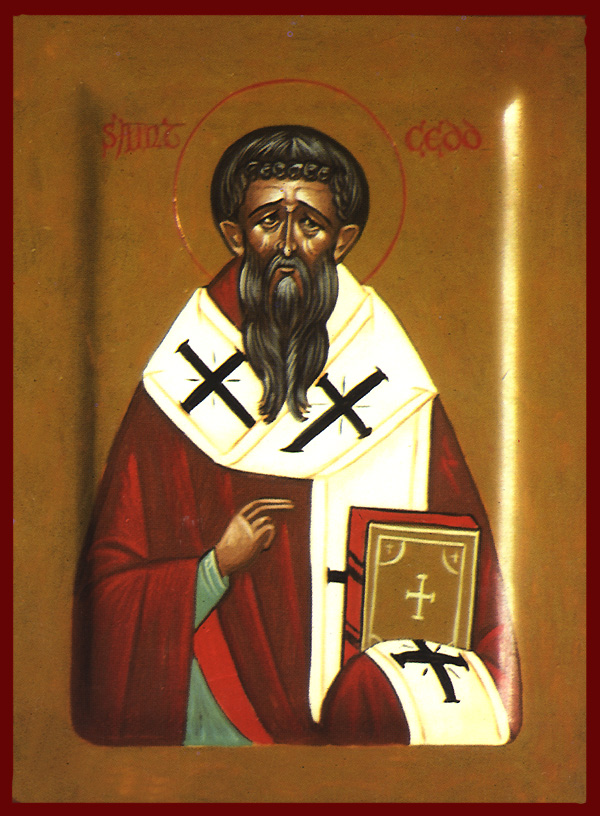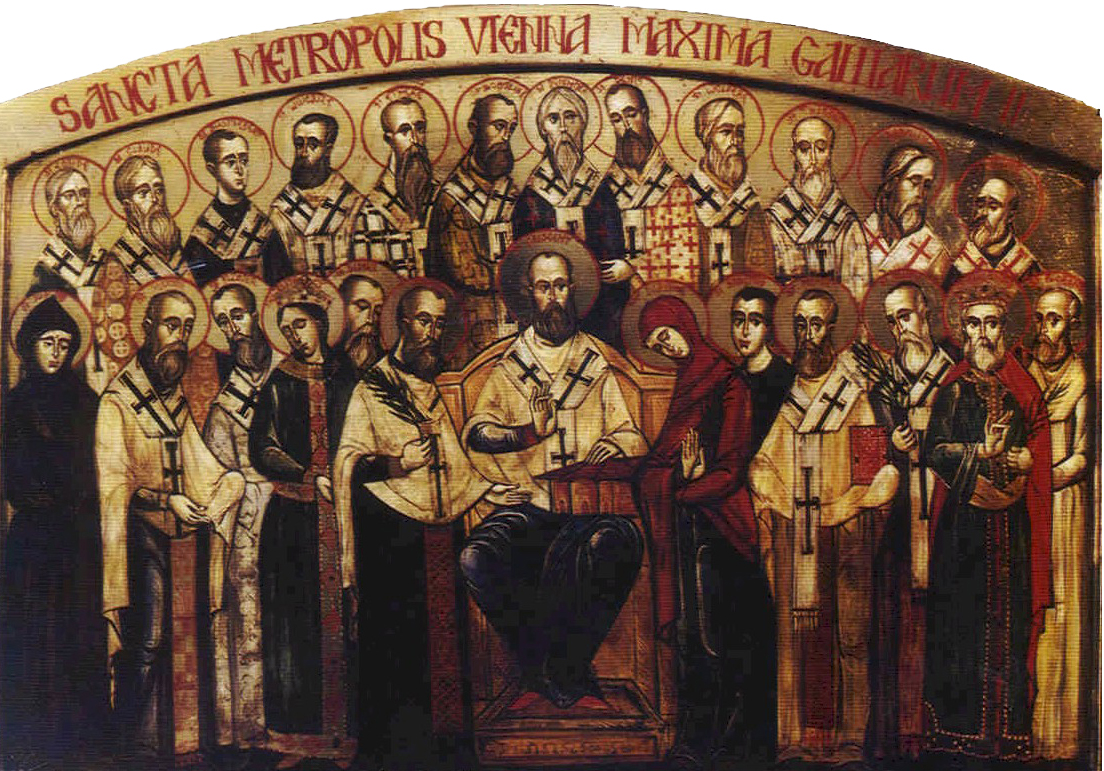
Orthodox Saints of the Pre-Schism
See of Rome
26th October (NS) — 13th October (OS) 2024
BERTHOALD of CAMBRAI, (Seventh Century), the fifth Bishop of Cambrai-Arras, about 50km / 30mi south of present-day Lille, France.
COLMAN of STOCKERAU, an Irish or Scottish monk who, when travelling in 1012, through Austria on his way to the Holy Land, was arrested as a spy. As he did not speak German, St. Colman was unable to defend himself against the charges. St. Colman was then tortured and hanged with criminals in Stockerau near Vienna. Miracles were worked at his grave and he was quickly venerated as a saint. St. Colman is one of the patron saints of Austria.
CÓEMGEN (COMGAN) the MONK, (Eighth Century), the son of Kelly, Prince of Leinster, Ireland, brother of St. Kentigerna (7th January), and uncle of St. Fáelán (Fillan) of Cluain Móescna (9th January). Following the death of his father he travelled, along with his sister and nephew (and possibly others) to Scotland where he established a monastery at Lochalsh, near Skye, in the Inner Hebrides serving as its first Abbot. St. Cóemgen lived a long and most holy life at Lochalsh, and following his repose his nephew, St. Fáelán, enshrined his relics at Iona.
FAUSTUS, JANUARIUS, and MARTIAL, three martyrs in Córdoba (southern Spain), whom the Roman Christian poet Prudentius (†413) called ‘The Three Crowns of Córdoba’. SS. Faustus, Januarius, and Martial were subjected to heinous torture and then burnt alive towards the beginning of the Diocletianic Persecution (303–313).
FYNCANA and FYNDOCA, (Date Unknown), the Aberdeen Breviary lists SS. Fyncana and Fyndoca as Scottish martyrs on this date, however no further information on these saints remains extant.
GERALD of AURILLAC, all that is known about St. Gerald is from a Life by St. Odo of Cluni who had never met St. Gerald, and there are no primary sources extant. St. Gerald was a Count of Aurillac in Gaul and though his greatest desire was to be a monk, his noble obligations impeded this. Therefore, following the advice of his friend Bishop Gausbert of Rodez, St. Gerald lived a life as close to monasticism as possible in the world, even founding a monastery and church on his estate. He reposed in 909, and many miracles have been attributed to his intercession.
REGIMBALD (REGINBALD, REGIMBAUT, REGIMBEAU) of SPEYER, received monastic tonsure at St. Ulrich's and St. Afra's Abbey (Kloster Sankt Ulrich und Afra) in Augsburg, Bavaria (southern Germany). He later spent time at the Abbey of the Theotokos and St. Sebastian (Kloster Heiligen Maria und St. Sebastian) in Ebersberg about 80km / 50mi south-east of Augsburg, before being chosen in 1022 to serve as the Abbot of Lorsch, in the present-day German state of Hesse. In 1032 St. Regimbald was consecrated the twenty-ninth Prince-Bishop of Speyer in the present-day area of the German states of Rhineland-Palatinate and Baden-Württemberg. St. Regimbald reposed in 1039.
ROMULUS (REMO) of GENOA, a noted theologian and early Bishop of Genoa (north-west Italy). St. Romulus reposed circa 641, at the coastal town of Matuziano 113km / 70mi to the south-west of Genoa. Matuziano later came to be called San Remo after him. No further information on St. Romulus is extant.
SIMBERT (SIMPERT, SINTHERT) of AUGSBURG, following the completion of his studies at Murbach Abbey in Alsace (north-eastern France), St. Simbert received monastic tonsure there, and in time was elected its Abbot. In 778 St Simbert was appointed the fourteenth Prince-Bishop of Augsburg, Bavaria (southern Germany) by Charlemagne, King of the Franks (r. 768–814). St. Simbert ruled that See, while remaining Abbot of Murbach until his repose circa 809. St. Simbert is one of the patron saints of the Roman Catholic Diocese of Augsburg.
VENANTIUS, a fifth century Abbot of the Abbey of St. Martin of Tours (abbaye de Saint-Martin de Tours) in Tours (west-central France).
Get your copy of Orthodox Saints of the British Isles today.
Available at Amazon or your favourite e-bookstore.
ADALGOTT of EINSIEDELN, a monk at Einsiedeln Abbey (Kloster Einsiedeln) in the present-day Swiss Canton of Schwyz. In 1012, he was chosen to serve as Abbot of Disentis Abbey (Reichskloster Disentis) in the present-day Swiss Canton of Graubünden (Grisons). St. Adalgott reposed at Disentis in 1031.
ALANUS of QUIMPER and ALORUS of QUIMPER, fifth century Bishops of Quimper in Brittany (north-western France). Beyond their popular cult and Liturgical commemoration there is no information on their lives extant.
ALBINUS (WITTA) of BÜRABURG, one of the group that went with St. Boniface of Mainz (5th June) to enlighten the peoples of Hesse and Thuringia (central Germany). In 741 St. Albinus was consecrated Bishop of Büraburg (part of present-day Fritzlar) in Hesse and served that See until his repose circa 760.
ALFRED (ÆLFRED) the GREAT, The Holy and Right-Believing King, St. Alfred the Great was King of the West Saxons and of the Anglo-Saxons. King St. Alfred defeated the Danish invaders and ensured the growth of the Church in England. During peacetime King St. Alfred worked to revive scholarship in the kingdom. Motivated by a lack of books in English, the language he believed primary instruction should be conducted in, King St. Alfred and his scholars undertook the translation into English of those books he deemed "most necessary for all men to know". King St. Alfred’s personal contribution to this undertaking included translations of Pope St. Gregory the Dialogist's (3rd September) Pastoral Care, and Dialogues, Boethius's Consolation of Philosophy, and St. Augustine's (28th August) Soliloquies, and the first fifty psalms of the Psalter. He is the only English monarch to be called "the Great” and is greatly venerated by many as a patriot and archetype of Christian monarchy. King St. Alfred the Great reposed in 899.
ANEURIN (GILDAS) and GWINOC, St. Aneurin and his son St. Gwinoc were sixth century Welsh monks. St. Gwinoc was the author of several Celtic poems. There are churches at Aberhafesp, and Llanwnog (both in Powys, Wales) dedicated to St. Gwinoc.
BEOÁN (BEAN, BEOANUS, MO BHIÓC) of MORTLACH, St. Bean was the first recorded Bishop of Mortlach in Banff, Aberdeenshire, Scotland. Nothing more is known of St. Bean’s life, other than that he reposed relatively soon after his consecration to the Episcopate, circa 1012.
CEDD of LASTINGHAM, St. Cedd was the brother of St. Ceadda (Chad) of Lichfield (2nd March), and a monk at Lindisfarne. He laboured for many years enlightening the inhabitants of Leicestershire, and parts of Lincolnshire and Derbyshire. Oswiu, King of Northumbria (r. 642–670), sent St. Cedd south to serve as Bishop of the East Saxons at the request of their king. During his episcopate, St. Cedd actively founded churches throughout his See as well as monasteries in Tilbury and Lastingham. It is believed St. Cedd succumbed to the plague, reposing 26th October circa 664. His feast was originally kept on 7th January, though in the old English Breviaries he had a special Office which was usually said on 2nd March. On the contemporary calendars of the Moscow Patriarchate, the Archdiocese of Thyateira and Great Britain (Œcumenical Patriarchate), and the Orthodox Church in America St. Cedd is still commemorated on 7th January.
CUTHBERT of CANTERBURY, St. Cuthbert succeeded St. Nothelm (17th October) as the eleventh Archbishop of Canterbury in 740. The earliest extant records identify St. Cuthburt as Abbot of Lyminge Abbey, in south-east Kent, and it is widely thought that St. Cuthbert was elevated to the See of Hereford circa 736. However, this is dependent upon the works of English monk and chronicler Florence of Worcester (†1118), and other post-conquest writers. The only contemporary record is in the Anglo-Saxon Chronicle, which states that St. Cuthbert was consecrated Archbishop of Canterbury in 740. Had he been Bishop of Hereford at the time he was elevated to the See of Canterbury, he would have been translated, as he already possessed the episcopal state. Due to the significant amount of time between the events and the post-conquest chronicling, it cannot be definitively stated St. Cuthbert was Bishop of Hereford prior to his elevation to Canterbury, however likely it might be. In 747, St. Cuthbert, along with Æthelbald, King of the Mercians (r. 716–757) presided over the second Council of Clovesho. Which, although primarily called as required by the seventh canon of the Synod of Herford, addressed several issues confronting the Church at the time. Not the least of which was the behaviour of the clergy, and excessive consumption of alcohol by the bishops; which had even prompted letters of complaint from St. Boniface of Mainz (5th June), not just to St. Cuthbert and King Æthelbald, but to the Holy See as well.
It is believed that St. Cuthbert obtained Papal permission for the, previously forbidden, practice of interring the dead within the walls of cities. He then mandated burial in churchyards and had the Chapel of St. John the Baptist (which unfortunately was destroyed by fire in 1067) built on the west side of Canterbury Cathedral. Though generally used as a baptistery, it was designed to be the burial place for not only himself, but also future Archbishops. St. Cuthbert reposed 26th October, 760, and was the first Archbishop of Canterbury to be buried in his own Cathedral, not in St. Augustine’s Abbey.
EATA of HEXHAM, a disciple of St. Áedán of Lindisfarne (31st August) from his youth, St. Eata received monastic tonsure at Lindisfarne. He was amongst the twelve monks selected to found a dependent monastery at Melrose in Roxburghshire circa 651, serving as Abbot. Approximately seven years later St. Eata left Melrose, along with St. Cuthbert of Lindisfarne (20th March) and others and founded a monastery at Ripon in Yorkshire. St. Eata served there as Abbot until 661, when he returned to Melrose.
Following the Synod of Whitby in 664 St. Eata was appointed Abbot of Lindisfarne, and in 678 he was consecrated Bishop of Lindisfarne as well. In 684, St. Eata was translated to the new Diocese of Hexham, serving as its first Bishop for the remaining two years of his life. St. Eata reposed in 686 following a bout of dysentery and was buried at Hexham Abbey. There is one church dedicated to him in England, at Atcham in Shropshire.
EDFRID (EADFRID), according to the English Menology, St. Edfrid was a Northumbrian priest who, while visiting Mercia, converted Merewalh, King of the Mercian sub-kingdom of Magonsæte, and preached the Gospel to his subjects. St. Edfrid is also believed to have founded Leominster Abbey at Hereford, Herefordshire, England. He reposed circa 675.
EVARISTUS, the fifth Pope of Rome from 99 or 96, until he was martyred circa 108.
GAUDIOSUS of SALERNO, there are no extant details of St. Gaudiosus’ life, it seems he was Bishop of Salerno (south-western Italy) in the mid-seventh century. His relics are enshrined in Naples.
GIBITRUDIS, a nun at the double Abbey of Our Lady of Faremoutiers (abbaye Notre-Dame de Faremoutiers), in Faremoutiers (north-central France) , where she was a disciple of the foundress St. Burgundofara (3rd April). St. Gibitrudis reposed circa 655. Nothing further is known of her life.
HUMBERT, a monk at the Abbey of St. Peter (Abtei St. Peter) at Fritzlar in the present-day German state of Hesse. St. Humbert was later chosen to serve as Prior of Büraburg (part of present-day Fritzlar) in Hesse, most-likely serving from circa 723 until his repose circa 741.
QUADRAGESIMUS of POLICASTRO, Pope St. Gregory the Dialogist (3rd September) lauded the holiness of this shepherd and (sub)deacon in Policastro in Campania (southern Italy). According to St. Gregory, St. Quadragesimus raised a man from the dead. St. Quadragesimus reposed circa 590.
ROGATIAN of CARTHAGE and FELICISSIMUS of CARTHAGE, St. Rogatian, a priest, and St. Felicissimus, a layman, of the church of Carthage (a present-day suburb of Tunis, Tunisia) were martyred in the early part of the Valerian Persecution (257–260). In his Epistle to Christian Prisoners, St. Cyprian of Carthage (16th September) encourages prisoners to follow the example of these saints, as St. Cyprian did, not two years later.
RUSTICUS of NARBONNE, fifth Bishop of Narbonne (southern France), the dates of his episcopacy vary with the source, however, Roman Catholic Priest and Critical Historian Louis Duchesne (†1922), gives the dates 427–circa 457, which are most likely the most accurate. Upon completion of his education, St. Rusticus spent time in Rome, then on the advice of St. Jerome (30th September) St. Rusticus entered the Abbey of Our Lady of Lérins (abbaye Notre Dame de Lérins) on one of the Lérins Islands in the Mediterranean Ocean off the Côte d’Azur in France where he was ordained to the priesthood, and in 427 consecrated Bishop of Narbonne. During his episcopacy, St. Rusticus attended the Third Œcumenical Council at Ephesus (present-day Selçuk, Turkey), in 431. St. Rusticus also had to contend with the spread of the Arian heresy (there has even been speculation that he had to contend with an Arian bishop claiming his See). This, combined with the Siege of Narbonne (752–759) by the Goths and dissention amongst his flock, so disheartened St. Rusticus that he wrote Pope St. Leo the Great (10th November) expressing his desire to resign his See. However, St. Leo convinced him to persevere. St. Rusticus then set about reconciling the Christian community of his See, built the Church of St. Genesius of Arles, now the Cathedral of Saints Justus and Pastor of Narbonne (Cathédrale Saint-Just-et-Saint-Pasteur de Narbonne), attended the Council of Arles in 435, and fought against Nestorianism. St. Rusticus reposed circa 457–462.
SIGIBALD of METZ, thirty-eighth Bishop of Metz (north-east France) serving from 716 until his repose circa 740. His episcopacy is especially remembered for the monasteries he had built, including St. Nabor Abbey, the present-day the Abbey-church of Saint-Nabor (Abbatiale Saint-Nabor de Saint-Avold), in Saint-Avold, Moselle in north-eastern France.
VALENTINE, and ENGRATIA, Martyrs of Segovia, brother and sister of St. Fructus (25th October). They were martyred at Segovia north-west of Madrid by Moorish invaders circa 715. Their relics, along with those of St. Fructus are enshrined at Segovia north-west of Madrid. The feast of these three saints is still celebrated on the week-end closest to the 25th of October by the community of Aguilafuente (north-western Spain).
Prior to the Schism the Patriarchate of Rome was Orthodox, and fully in communion with the Orthodox Church. As Saint John of Shanghai and San Francisco +1966 said “The West was Orthodox for a thousand years, and her venerable Liturgy is far older than any of her heresies”.
Details of British Saints excerpted from Orthodox Saints of the British Isles.
Details of continental saints from these sources.
In many cases there are several spelling versions of the names of saints from the British Isles. I use the Oxford Dictionary of National Biography version as the primary version with the more prevalent version in parenthesis e.g. Ceadda (Chad) of Lichfield.
